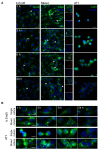Behind Brain Metastases Formation: Cellular and Molecular Alterations and Blood-Brain Barrier Disruption
- PMID: 34209088
- PMCID: PMC8268492
- DOI: 10.3390/ijms22137057
Behind Brain Metastases Formation: Cellular and Molecular Alterations and Blood-Brain Barrier Disruption
Abstract
Breast cancer (BC) brain metastases is a life-threatening condition to which accounts the poor understanding of BC cells' (BCCs) extravasation into the brain, precluding the development of preventive strategies. Thus, we aimed to unravel the players involved in the interaction between BCCs and blood-brain barrier (BBB) endothelial cells underlying BBB alterations and the transendothelial migration of malignant cells. We used brain microvascular endothelial cells (BMECs) as a BBB in vitro model, under conditions mimicking shear stress to improve in vivo-like BBB features. Mixed cultures were performed by the addition of fluorescently labelled BCCs to distinguish individual cell populations. BCC-BMEC interaction compromised BBB integrity, as revealed by junctional proteins (β-catenin and zonula occludens-1) disruption and caveolae (caveolin-1) increase, reflecting paracellular and transcellular hyperpermeability, respectively. Both BMECs and BCCs presented alterations in the expression pattern of connexin 43, suggesting the involvement of the gap junction protein. Myosin light chain kinase and phosphorylated myosin light chain were upregulated, revealing the involvement of the endothelial cytoskeleton in the extravasation process. β4-Integrin and focal adhesion kinase were colocalised in malignant cells, reflecting molecular interaction. Moreover, BCCs exhibited invadopodia, attesting migratory properties. Collectively, hub players involved in BC brain metastases formation were unveiled, disclosing possible therapeutic targets for metastases prevention.
Keywords: adhesion; blood–brain barrier; breast cancer brain metastases; cellular communication; extravasation; paracellular and transcellular migration.
Conflict of interest statement
The authors declare no conflict of interest.
Figures









References
-
- Kimberly D., Miller K.D., Nogueira L., Mariotto A.B., Rowland J.H., Yabroff K.R., Alfano C.M., Jemal A., Kramer J.L., Siegel R.L. Cancer treatment and survivorship statistics, 2019. CA Cancer J. Clin. 2019;69:363–385. - PubMed
-
- Krishnan M., Krishnamurthy J., Shonka N. Targeting the sanctuary site: Options when breast cancer metastasizes to the brain. Oncology. 2019;33:683730. - PubMed
MeSH terms
Substances
Grants and funding
LinkOut - more resources
Full Text Sources
Medical
Miscellaneous

